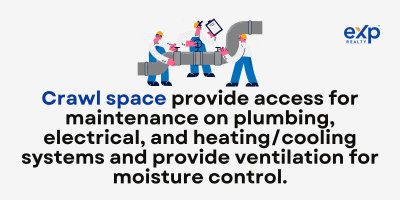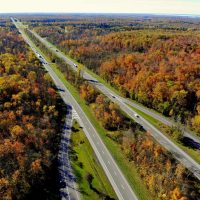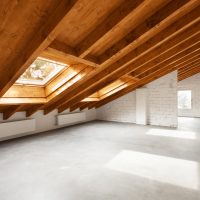Do you know what may be lurking beneath your house? A crawl space can hide many potential hazards, from rodents to water damage. However, there are several benefits to having a crawl space in your home.
In this blog post, we’ll explore what a crawl space is, discuss some common risks they pose, identify signs that something is wrong within them, and outline how best to maintain yours for optimal security.
If you are planning on buying a home, chances are likely that you could have a crawl space, so keep reading to prepare.
What Is a Crawl Space?
A crawl space is a shallow, unfinished area beneath the floor of a home. It’s typically between 18 and 36 inches tall, and you can access it inside or outside the house. One of the biggest benefits of a crawl space is to provide access for maintenance on plumbing, electrical, and heating/cooling systems and provide ventilation for moisture control.
Why Do Some Homes Have Crawl Spaces?
Certain homes are built with crawl spaces as an alternative to building on a concrete slab. The purpose of installing one is at the preference of the builder or the homeowner who is constructing a new home. A benefit of crawl spaces is that homeowners have easy access to maintenance work on plumbing, insulation, wiring, etc.
When properly maintained, crawl spaces can help contribute to improved indoor air quality, as a home is ventilated from the bottom to the top. If the crawl space is dry and well-maintained, the home will be as well.
Potential Hazards in a Crawl Space
Poorly maintained crawl spaces can lead to moisture and mold, pest infestation, air quality concerns, fire hazard, and structural damage if not adequately managed.
Moisture and Mold
Mold caused by excessive water in a neglected crawl space can be hazardous to one’s health, potentially leading to respiratory issues and the spread of disease-causing bacteria. If ignored, mold growth in a crawl space can spread throughout your residence, potentially resulting in respiratory problems like asthma or allergies for those living there.
Pest Infestation
When stagnant water is on dirt floors without adequate ventilation, it can draw pests such as rodents or bugs, which could introduce hazardous bacteria into the home.
Air Quality Concerns
Crawl space foundations with inadequate ventilation can lead to poor air quality. This air can find its way into living spaces which can cause respiratory issues.
Structural Damage
Poor maintenance on your crawl space could result in structural damage from rot caused by excess moisture trapped within its walls and floors. Not only does this put you at risk for costly repairs, but it could also weaken the foundation making your entire house unsafe if left unchecked for too long.
The Importance of Regular Crawl Space Inspection
It is essential for homeowners to routinely examine their crawl space for indications of issues such as water damage, bug infestations, and mold growth to prevent possible hazards.
If left unchecked, these issues can become severe and require expensive repairs or put family members at risk of illness or injury due to hazardous conditions created by neglecting regular maintenance on their property’s hidden areas like the crawl space.
Being mindful of the risks in a crawl space is essential, as these can bring about health problems, and structural harm. By understanding the warning signs of water damage, pest infestation, and mold growth in your crawl space, you can take preventive measures before any serious issues arise.
Air Quality
Routinely inspecting and caring for your crawl space foundations can bring many advantages, such as enhanced air quality and decreased probability of structural damage.
Improving the air quality in your home starts with regular maintenance and inspection of your crawl space. Annual inspections allow you to identify any potential issues early on so you can address them before they become more serious health risks. Additionally, ensuring that vents are clear and unblocked will ensure proper airflow throughout the house.
Structural Issues
Structural damage is another common issue associated with poorly maintained crawl spaces. Regular inspections make it easier to spot signs such as water leaks or insect infestations that could lead to thousands of dollars in repairs.
Pest Control
Finally, pest infestations are another concern regarding maintaining a healthy environment within your home’s crawl space; pests like rodents and insects thrive in dark, damp places. Regular inspections help you catch any potential signs early on to identify a termite infestation or dust mites.
Regular upkeep and examination of your crawl space guarantee a secure and healthy home environment. Preparing for an inspection or maintenance visit is the next step in keeping your crawl space functioning correctly.
FAQs
Below are some frequently asked questions about crawl spaces.
What is the purpose of a crawl space?
A crawl space provides a buffer between your home and the soil/land it is built on. Some homes are built on a slab of concrete, others have a crawl space in between.
What are the negatives of a crawl space?
The downside of crawl spaces is that they are challenging to insulate, given their narrow space. They often have moisture issues, leading to unpleasant musty smells and air quality issues.
What are the benefits of a crawl space?
A crawl space is more affordable than a concrete slab foundation, and it gives access to plumbing and wiring. Homeowners can access the area for crawl space repair.
Do crawl spaces get wet?
Yes, some crawlspaces may have excessive moisture problems. In a typical crawl space, you may see condensation on your foundation walls and even puddles forming on the floor when humidity is high.
Does homeowners insurance cover crawl space issues?
Most homeowners insurance do not cover crawl space issues; however, there may be some exceptions depending on the cause of your problem. For example, if the source of moisture comes from flood water, the insurance may help you with mold remediation.
Does crawl space add value to home?
The crawl space will not add value to your home but encapsulating the space will. Homeowners should insulate the walls and install drainage, vapor barriers, and a ventilation system. Every encapsulation measure will add more value.
Is it better to have a crawl space or slab?
A slab foundation is better in humid climates, but a crawl space is better for homes in areas where there is flooding. You can also consider concrete blocks as another option.
How often should you clean your crawl space?
You should clean and inspect your crawl space at least once a year. Homeowners should be looking for any issues requiring future repairs and paying close attention to excessive moisture and signs of rodents. Inspections should also include any problems with the walls of the foundation.
Do crawl spaces need drains?
Not all crawl spaces will need a drainage system. However, if you see a pattern of standing water building up in your crawl space, it would be wise to install a drainage system.
Is there always mold in crawl space?
Mold spores are widespread in spaces because of the high level of humidity. Keeping your crawl space dry is essential to prevent mold from growing. Once you see mold developing, you must address it immediately. Mold can spread quickly throughout your home and become very costly to remediate. It is recommended to maintain a RH level below 50% to prevent mold growth.
Should I keep my crawl space vents open or closed?
The best way to prevent moisture issues in a crawl space is to fully encapsulate the crawl space, add a drainage system if needed, seal the vents, and add a dehumidifier. Now the crawl space is more like a finished basement with conditioned air.
Do all crawl spaces need a sump pump?
There is a big difference between standing water and high RH. If there is standing water in a crawl space then you need a sump pump. If the RH is high, then you need a dehumidifier.
How do I dry out my crawl space under my house?
A dehumidifier is an effective method for drying the area. It is essential to keep the humidity levels low.
What should not be stored in a crawl space?
You should avoid storing important papers, books, or photos in certain types of crawl spaces. The moisture level in the unfinished space can easily damage these items, and you would not want to lose precious mementos.
How do you moisture proof a crawl space?
Homeowners can easily moisture-proof a crawl space by installing a thick plastic sheet to the ground and walls.
Conclusion
Maintaining and inspecting your crawl space is essential to remain safe, dry, and free from potential hazards. Regular maintenance can also help you identify signs of trouble before they become a significant problem. Knowing what may be under your house is critical to understanding the importance of maintaining and inspecting your crawl space.
Now that you’re prepared to maintain a crawl space, reach out to a local real estate agent to help you find your perfect home.









